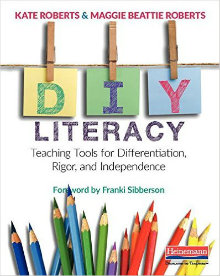DIY Literacy Tools for Blended Learning
DIY Literacy: Teaching Tools for Differentiation, Rigor, and Independence
By Kate Roberts and Maggie Beattie Roberts
(Heinemann, 2016 – Learn more)
 Reviewed by Nicolette Lesniak
Reviewed by Nicolette Lesniak
School is not just about teaching our students what they need to know to be successful, it’s also about making sure they have the tools they need to readily access new material and build upon their content knowledge.
In DIY Literacy: Teaching Tools for Differentiation, Rigor, and Independence Kate and Maggie Roberts help educators provide those tools.
 This guide is useful for a teacher who wants to build upon their practice to implement teaching charts, demonstration notebooks, and book marks to meet the needs of all the learners in their classroom as well as build upon a student’s self-efficacy when it comes to analyzing and evaluating text.
This guide is useful for a teacher who wants to build upon their practice to implement teaching charts, demonstration notebooks, and book marks to meet the needs of all the learners in their classroom as well as build upon a student’s self-efficacy when it comes to analyzing and evaluating text.
Using visuals to differentiate
As an educator working with urban youth, I enjoyed reading this book and expanding my repertoire of skills in several areas, including using visuals to differentiate the curriculum and increase rigor. The use of the tools mentioned in the guide helps students recall what was taught as well as motivate them to work harder and to the best of their abilities.
I currently work in a blended model school in Chicago. This school allows students to work on the credits they need to graduate in a self-paced environment. I must adapt my teaching style to fit the many needs of the students as well as the content areas.
One idea I quickly adopted from the authors: demonstration notebooks (collections of teaching texts for conferencing with students). I created notebooks for reading comprehension strategies and also for math concepts and applications. They helped me meet individual student needs and also provided a new resource for my colleagues.
Expanded charts for my blended classroom
The authors also showed me how to expand my use of charts, including process charts and micro-progression of skills charts to fit student needs.
Since I work at a blended model school, the students do not take home textbooks. Instead they can assess their textbooks on the computer, and they have a notebook where they write detailed notes. The use of the charts allows them to easily remember the key concepts in the lessons as well as to build upon their skills with the use of the same charting tool (and by using visual note-taking where they incorporate pictures and diagrams with their notes).
Although the authors suggest displaying student work in the classroom, this was not beneficial to me since students in my school are working on individual subjects that they need per their graduation plan.
What was most helpful
The most useful concept for me was the demonstration notebook. I made a generalized chart focusing on a reading comprehension strategy or math concept, and then when I worked with the student we created a specific chart in their notebook geared to the subject matter they were working with.
At time students forget or become confused about what they’ve learned previously, but with the use of accountable talk (in which higher order thinking questions are asked) and referring to their notes (which included the teacher charts that they expanded upon), they could access prior knowledge and expand upon the concept that was being assessed.
I highly recommend this guide to rachet up your use of teaching charts in the classroom, as well as increase rigor and build self-sufficiency in working with complex literacy and informational texts.
Also see: Sandy Wisneski’s MiddleWeb review of this book
_____________
Nicolette Lesniak is an educator with over ten years of experience teaching at-risk students in Chicago. She enjoys mentoring and supporting teachers with the everyday challenges and joys of teaching diverse learners. She lives in Northwest Indiana with her husband Jim and her cat Charlie.
































